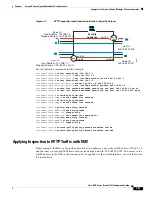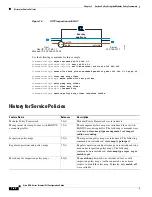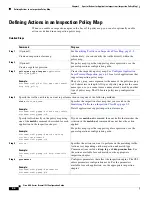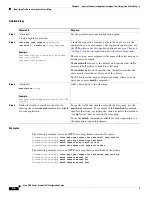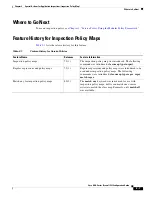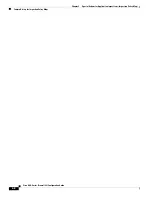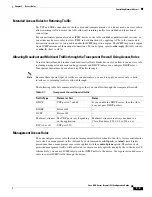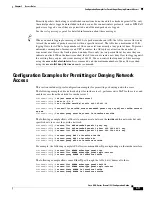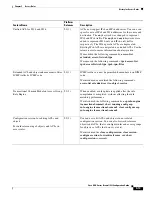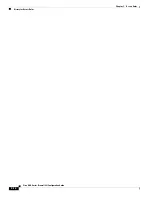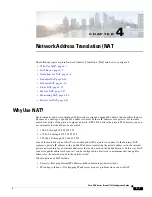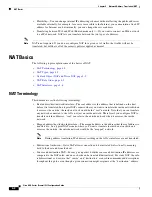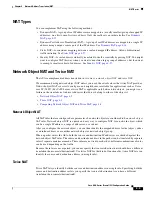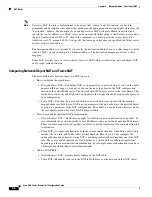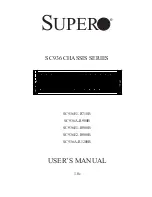
3-5
Cisco ASA Series Firewall CLI Configuration Guide
Chapter 3 Access Rules
Controlling Network Access
Extended Access Rules for Returning Traffic
For TCP and UDP connections for both routed and transparent mode, you do not need an access rule to
allow returning traffic because the ASA allows all returning traffic for established, bidirectional
connections.
For connectionless protocols such as ICMP, however, the ASA establishes unidirectional sessions, so
you either need access rules to allow ICMP in both directions (by applying ACLs to the source and
destination interfaces), or you need to enable the ICMP inspection engine. The ICMP inspection engine
treats ICMP sessions as bidirectional connections. To control ping, specify
echo-reply
(
0
) (ASA to host)
or
echo
(
8
) (host to ASA).
Allowing Broadcast and Multicast Traffic through the Transparent Firewall Using Access Rules
In routed firewall mode, broadcast and multicast traffic is blocked even if you allow it in an access rule,
including unsupported dynamic routing protocols and DHCP (unless you configure DHCP relay).
Transparent firewall mode can allow any IP traffic through.
Note
Because these special types of traffic are connectionless, you need to apply an access rule to both
interfaces, so returning traffic is allowed through.
The following table lists common traffic types that you can allow through the transparent firewall.
Management Access Rules
You can configure access rules that control management traffic destined to the ASA. Access control rules
for to-the-box management traffic (defined by such commands as
http
,
ssh
, or
telnet
) have higher
precedence than a management access rule applied with the
control-plane
option. Therefore, such
permitted management traffic will be allowed to come in even if explicitly denied by the to-the-box ACL.
Alternatively, you can use ICMP rules to control ICMP traffic to the device. Use regular extended access
rules to control ICMP traffic through the device.
Table 3-1
Transparent Firewall Special Traffic
Traffic Type
Protocol or Port
Notes
DHCP
UDP ports 67 and 68
If you enable the DHCP server, then the ASA
does not pass DHCP packets.
EIGRP
Protocol 88
—
OSPF
Protocol 89
—
Multicast streams The UDP ports vary depending
on the application.
Multicast streams are always destined to a
Class D address (224.0.0.0 to 239.x.x.x).
RIP (v1 or v2)
UDP port 520
—
Содержание ASA 5512-X
Страница 5: ...P A R T 1 Service Policies and Access Control ...
Страница 6: ......
Страница 50: ...3 14 Cisco ASA Series Firewall CLI Configuration Guide Chapter 3 Access Rules History for Access Rules ...
Страница 51: ...P A R T 2 Network Address Translation ...
Страница 52: ......
Страница 126: ...5 28 Cisco ASA Series Firewall CLI Configuration Guide Chapter 5 NAT Examples and Reference DNS and NAT ...
Страница 127: ...P A R T 3 Application Inspection ...
Страница 128: ......
Страница 255: ...P A R T 4 Connection Settings and Quality of Service ...
Страница 256: ......
Страница 288: ...12 14 Cisco ASA Series Firewall CLI Configuration Guide Chapter 12 Quality of Service History for QoS ...
Страница 303: ...P A R T 5 Advanced Network Protection ...
Страница 304: ......
Страница 339: ...P A R T 6 ASA Modules ...
Страница 340: ......
Страница 398: ...17 28 Cisco ASA Series Firewall CLI Configuration Guide Chapter 17 ASA CX Module History for the ASA CX Module ...

